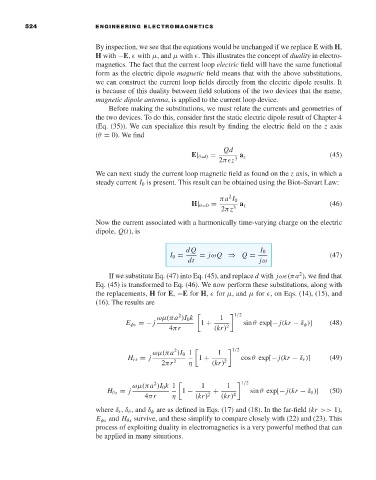Page 542 - Engineering Electromagnetics, 8th Edition
P. 542
524 ENGINEERING ELECTROMAGNETICS
By inspection, we see that the equations would be unchanged if we replace E with H,
H with −E, with µ, and µ with . This illustrates the concept of duality in electro-
magnetics. The fact that the current loop electric field will have the same functional
form as the electric dipole magnetic field means that with the above substitutions,
we can construct the current loop fields directly from the electric dipole results. It
is because of this duality between field solutions of the two devices that the name,
magnetic dipole antenna,is applied to the current loop device.
Before making the substitutions, we must relate the currents and geometries of
the two devices. To do this, consider first the static electric dipole result of Chapter 4
(Eq. (35)). We can specialize this result by finding the electric field on the z axis
(θ = 0). We find
Qd
E| θ=0 = a z (45)
2π z 3
We can next study the current loop magnetic field as found on the z axis, in which a
steady current I 0 is present. This result can be obtained using the Biot–Savart Law:
2
πa I 0
H| θ=0 = a z (46)
2πz 3
Now the current associated with a harmonically time-varying charge on the electric
dipole, Q(t), is
dQ I 0
I 0 = = jωQ ⇒ Q = (47)
dt jω
2
If we substitute Eq. (47) into Eq. (45), and replace d with jω (πa ), we find that
Eq. (45) is transformed to Eq. (46). We now perform these substitutions, along with
the replacements, H for E, −E for H, for µ, and µ for ,on Eqs. (14), (15), and
(16). The results are
2
ωµ(πa )I 0 k 1 1/2
E φs =− j 1 + sin θ exp[− j(kr − δ φ )] (48)
4πr (kr) 2
2
ωµ(πa )I 0 1 1 1/2
H rs = j 1 + cos θ exp[− j(kr − δ r )] (49)
2πr 2 η (kr) 2
ωµ(πa )I 0 k 1 1 1 1/2
2
H θs = j 1 − + sin θ exp[− j(kr − δ θ )] (50)
4πr η (kr) 2 (kr) 4
where δ r , δ θ , and δ φ are as defined in Eqs. (17) and (18). In the far-field (kr >> 1),
E φs and H θs survive, and these simplify to compare closely with (22) and (23). This
process of exploiting duality in electromagnetics is a very powerful method that can
be applied in many situations.

